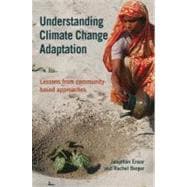
Note: Supplemental materials are not guaranteed with Rental or Used book purchases.
Purchase Benefits
What is included with this book?
| Preface | p. vii |
| Acknowledgements | p. ix |
| Introduction: understanding community-based adaptation | p. 1 |
| Abstract | p. 1 |
| The development challenge | p. 1 |
| The international context | p. 4 |
| Climate predictions: understanding uncertainty | p. 6 |
| Vulnerability and adaptation | p. 13 |
| Adaptive capacity and resilience | p. 17 |
| Knowledge, vulnerability and adaptation: a coherent approach | p. 26 |
| Culture, communities and adaptation practice | p. 33 |
| Structure of the book | p. 36 |
| Erosion and flooding in northern Bangladesh | p. 39 |
| Abstract | p. 39 |
| Introduction | p. 39 |
| Community-based adaptation in the northern charlands | p. 41 |
| Lessons and challenges | p. 49 |
| Conclusion | p. 52 |
| Changing seasons and flash flooding in the foothills of the Nepal Himalaya | p. 55 |
| Abstract | p. 55 |
| Introduction | p. 55 |
| Community-based adaptation in the middle hill region of Nepal (Chitwan District) | p. 58 |
| Lessons and challenges | p. 66 |
| Conclusion | p. 68 |
| Desert and floodplain adaptation in Pakistan | p. 71 |
| Abstract | p. 71 |
| Introduction | p. 71 |
| Community-based adaptation in rural Pakistan | p. 73 |
| Lessons and challenges | p. 82 |
| Conclusion | p. 85 |
| Increasing paddy salinity in coastal Sri Lanka | p. 87 |
| Abstract | p. 87 |
| Introduction | p. 87 |
| Community-based adaptation in coastal communities | p. 89 |
| Lessons and challenges | p. 97 |
| Conclusion | p. 98 |
| Increasing drought in arid and semi-arid Kenya | p. 101 |
| Abstract | p. 101 |
| Introduction | p. 101 |
| Community-based adaptation in arid and semi-arid areas | p. 103 |
| Lessons and challenges | p. 111 |
| Conclusion | p. 113 |
| Multiple pressures on pastoralism in semi-arid Niger | p. 115 |
| Abstract | p. 115 |
| Introduction | p. 115 |
| Community-based adaptation among the Tamasheq | p. 117 |
| Lessons and challenges | p. 124 |
| Conclusion | p. 129 |
| Declining water resources in Sudan's Red Sea coastal belt | p. 131 |
| Abstract | p. 131 |
| Introduction | p. 131 |
| Adapting to drought in Arba'at | p. 134 |
| Lessons and challenges | p. 139 |
| Conclusion | p. 143 |
| Extreme weather in the Peruvian high Andes | p. 147 |
| Abstract | p. 147 |
| Introduction | p. 147 |
| Community-based adaptation in Andean Peru | p. 149 |
| Lessons and challenges | p. 159 |
| Conclusion | p. 161 |
| Conclusion: community-based adaptation in practice | p. 163 |
| Abstract | p. 163 |
| The elements of adaptation | p. 163 |
| Scaling up community-based adaptation | p. 172 |
| References | p. 179 |
| Index | p. 185 |
| Table of Contents provided by Ingram. All Rights Reserved. |
The New copy of this book will include any supplemental materials advertised. Please check the title of the book to determine if it should include any access cards, study guides, lab manuals, CDs, etc.
The Used, Rental and eBook copies of this book are not guaranteed to include any supplemental materials. Typically, only the book itself is included. This is true even if the title states it includes any access cards, study guides, lab manuals, CDs, etc.